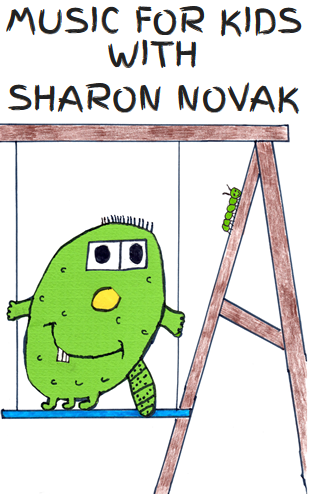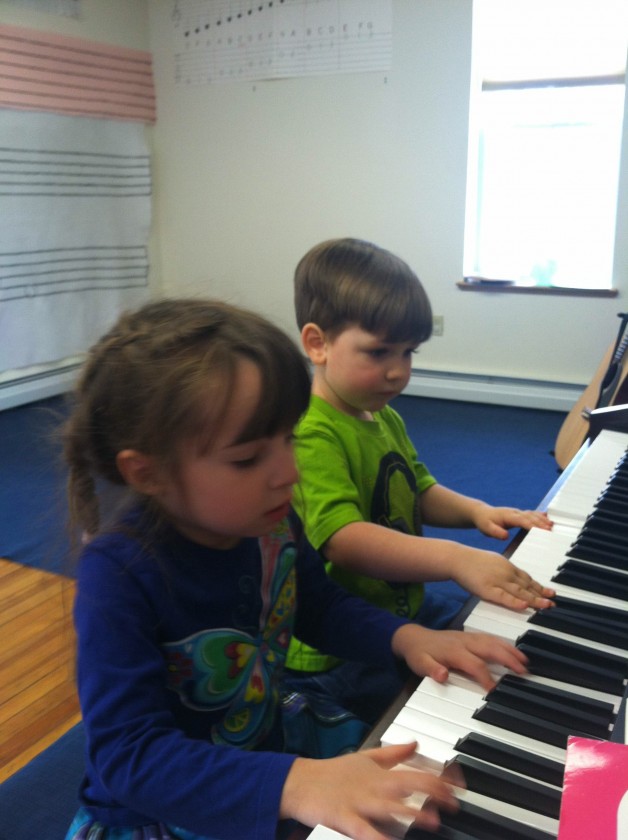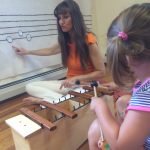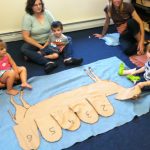How Do You Know When Your Child is Ready for Piano Lessons?
As I work with young children everyday, I have the privilege of watching them develop cognitively and musically. I watch very young children go from banging random beats on a drum gradually learn to follow a steady beat and then finally be able to hold a steady beat through the duration of an entire song. I watch 3 year old children struggle with playing one hand at a time on a xylophone finally learn to handle alternating hands on two different notes.
I have learned what to expect from children at different ages. In the world of music, cognitive development is very evident for children of different ages. One place that this is clearly noticeable is on the piano. Children love when I bring a piano to a preschool classroom. All of their eyes light up and they can hardly wait for their turn to be able to play on the keyboard. Little do they realize that they are about to take one of their first placement examinations. I love telling preschool teachers to watch as children between 3 and 4 years old go to the piano. I already know that the 4 year old children are going to be able to respond to my directions much better than the 3 year old children.
These are the tests. How a child responds is going to tell the teacher, mom, or dad whether his or her child is ready to take piano lessons.
1. The first thing I have children do is find their left and right hands. They will use their left hand to play the low notes (low left) and their right hand to play the high notes (high right). Usually both three and four year old children have very little trouble with this (aside from their inability to differentiate between left and right, but we can work through that). Frequently if I have a standing keyboard or piano I will have the children line up behind me so they can mirror me with their left and right hands before they go to the piano. Now of course, this is where songs like the “Hokey Pokey”, “Mother Gooney Bird” and my own “Walking to the Left” help children learn the difference between their left and right hands. Sometimes we just have to work sitting down calling one child up at a time to come and play the keyboard.
2. The next test will divide the 3 and 4 year old children. I have the children look at the keyboard and look for the groups of 3 black notes first. I will have a couple of children at a time come up to find as many sets as they can. I stick with the sets of 3 black notes first so that I don’t overload them with too much information at one time. Some of the 4 year old children can do this with no problem. Some of the 4 year old children struggle. Almost no 3 year old children can grasp this concept. I will then have them come up two or three at a time to find the sets of 2. This reinforces the thinking of looking for the sets. The results rarely vary between children or age groups. After we have completed this test I can usually find at least 2 or 3 children who are ready to begin working on simple exercises at the piano. This has been working for me without fail for years.
3. Now, if I have a group of 4 and 5 year old children, we can progress to learning to play “Hot Cross Buns” on the 3 black notes. They totally love the feeling of success they have when they learn to play this simple song. In a group when we do this for the first time, I don’t worry too much about fingering. I begin to focus on fingering if I have the children doing piano activities for more than one week or if I am teaching individual lessons.
4. The next step will most likely happen in older groups or one on one with younger children. We will learn to find middle C. This will involve proper fingering on the black notes. I start with a thumbs on C approach. I will have children find the sets of two black notes. They will place finger number 2 (tall man) on the first black note (C#) and finger number 3 (middle finger) on the second black note (D#). After these initial steps have been taken, we can begin finding notes with both hands. I personally prefer a thumbs on C approach with young children. This is the step where more serious piano lessons begin.
No matter what approach to teaching happens with a young child, these steps are amazingly helpful and accurate in telling a parent if his or her child is ready for piano lessons. One important transition phase in learning piano is the ability to read. Before and after this happens are two different worlds when learning piano. Learning piano and learning to read go hand in hand for a child who is in kindergarten. Children learn to effectively read music as they learn to read words. Children between the ages of 4 and 5 but still cannot read will definitely benefit from some group or even one on one time, but the lessons will happen at a slower pace. And may I say that even though the pace is slower, there is nothing like an early introduction to the keyboard. Foundations are laid that will not be forgotten.



